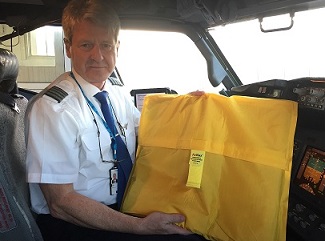 A pilot holding an AvSax fire containment bag
A pilot holding an AvSax fire containment bag
Fire containment bags on board aircraft are vital in the aftermath of a fire in an electronic device such as a mobile phone or a laptop.
The Civil Aviation Authority (CAA) in the UK has now issued guidance on how the bags could help safety on board passenger planes after a steep rise in such incidents in recent years.
New products have been devised to deal with such emergencies including the AvSax fire containment bag now on board 65 airline companies worldwide.
Batteries that overheat can go into what’s known as thermal runaway.
When one cell in a battery overheats it can produce enough heat – up to 900°C (1652°F) – to cause adjacent cells to overheat. This can cause a lithium battery fire with the potential to cause damage to the aircraft and putting lives at risk. The Federal Aviation Administration (FAA) in the USA has reported 225 battery incidents occurring in cargo or baggage since 1991, many of these involving lithium batteries. Ominously, of those, 46 were reported in 2017.
Up to now the advice has been to douse the flames on the burning device and then leave it for up to 15 minutes to see if it reignites. This could mean passengers being evacuated to other parts of the plane.
But if the crew have AvSax to hand they can put the device straight in the bag once the fire has been put out and the passengers can return to their seats.
In its guidance the CAA states: “Since the development of the International Civil Aviation Organization (ICAO) guidance (on dealing with an in-flight battery fire), new products designed for use in response to lithium battery thermal runaway events have become available.
“Products which provide both a cooling and containment capability are typically more aligned to the existing ICAO guidance as when used they are filled with water or other non-flammable liquid to act as a cooling agent.
“After knocking down flames, it could conceivably take just a couple of seconds for a personal electronic device to be placed inside a containment bag, allowing it to be moved to a place of safety. Passengers could then return to their seats, mitigating potential unrelated safety hazards such as injury in the case of severe turbulence. Equally, the effect on flight crew in carrying out their duties following an event on the flight deck would be minimised.”
The CAA recognises that, subject to a suitable risk assessment by an operator, placing a portable electronic device in a hydrated containment bag may be safer than waiting 15 minutes before moving the device, because during this time the device may reignite which could result in flaming projectiles being ejected in the cabin.
By adding two litres of cold liquid (water or soft drinks) to Avsax, a polymer is activated which simultaneously cools a portable electronic device to prevent further thermal runaway, and suppresses any blast/fire effect should further runway occur.
There are now 13,000 AvSax on board aircraft worldwide and they work in the way described by the CAA. The bag – which won the prestigious Queen’s Award for Enterprise this year - has been used 27 times to deal with emergencies since the start of 2017.
* Written by Andy Hirst at AH! PR http://www.ah-pr.com/